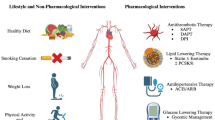Abstract
Angiotensin II, via AT1 receptors plays a key role in endothelial dysfunction and therefore, in atherogenesis. In order to assess whether long-term blockade of these receptors improve peripheral and coronary endothelial function, 13 patients were treated by candesartan cilexetil (AT2B, 16 mg/d in 10 patients and 8 mg in 3). Flow-mediated dilation (FMD, measured with ultra-sound technique) in the brachial artery and cold pressor testing (CPT)-induced changes in myocardial blood flow (MBF, measured with positron emission tomography) were assessed before and after a 6 month treatment period. AT2B did not alter FMD: 5.0 ± 1.2% vs. 6.4 ± 0.9% after treatment. MBF increased significantly during CPT before and after AT2B. Although AT2B did not significantly modify heart rate and blood pressure, MBF normalized to the rate pressure product (MBF/RPP × 10000) was significantly higher and this change remained significant during CPT: it increased from 0.94 ± 0.05 ml/g/min to 1.14 ± 0.09 ml/g/min after AT2B (P < .05) and did not decrease during CPT (1.12 ± 0.08 ml/g/min). Moreover, these AT2B-induced changes in normalized MBF were significantly correlated with the changes in FMD (r = 0.66, P < 0.05).
Thus, long-term AT2B improves coronary vasomotion. Although no significant alteration in peripheral conduit endothelial function has been observed, treatment-induced FMD changes seem to be a predictor of coronary circulation improvement.
Similar content being viewed by others
References
Mancini GB, Henry GC, Macaya C, et al. Angiotensin-converting enzyme inhibition with quinapril improves endothelial vasomotor dysfunction in patients with coronary artery disease. The TREND (Trial on Reversing ENdothelial Dysfunction) Study. Circulation 1996;94:258–265.
Anderson TJ, Elstein E, Haber H, Charbonneau F. Comparative study of ACE-inhibition, angiotensin II antagonism, and calcium channel blockade on flow-mediated vasodilation in patients with coronary disease (BANFF study). J Am Coll Cardiol 2000;35:60–66.
Schuh JR, Blehm DJ, Frierdich GE, McMahon EG, Blaine EH. Differential effects of renin-angiotensin system blockadeon atherogenesis in cholesterol-fed rabbits. J Clin Invest 1993;91:1453–1458.
Berkenboom G, Langer I, Carpentier Y, Grosfils K, Fontaine J. Ramipril prevents endothelial dysfunction induced by oxidized low-density lipoproteins: A bradykinin-dependent mechanism. Hypertension 1997;30:371–376.
Rajagopalan S, Kurz S, Munzel T, et al. Angiotensin II-mediated hypertension in the rat increases vascular superoxide production via membrane NADH/NADPH oxidase activation. Contribution to alterations of vasomotor tone. J Clin Invest 1996;97:1916–1923.
Libby P. Molecular bases of the acute coronary syndromes. Circulation 1995;91:2844–2850.
Saino A, Pomidossi G, Perondi R, et al. Intracoronary angiotensin II potentiates coronary sympathetic vasoconstriction in humans. Circulation 1997;96:148–153.
Urata H, Kinoshita A, Misono KS, Bumpus FM, Husain A. Identification of a highly specific chymase as the major angiotensin II-forming enzyme in the human heart. J Biol Chem 1990;265:22348–22357.
Rajagopalan S, Brook R, Mehta RH, Supiano M, Pitt B. Effect of losartan in aging-related endothelial impairment. Am J Cardiol 2002;89:562–566.
Anderson EA, Mark AL. Flow-mediated and reflex changes in large peripheral artery tone in humans. Circulation 1989;79:93–100.
Celermajer DS, Sorensen KE, Gooch VM, et al. Non-invasive detection of endothelial dysfunction in children and adults at risk of atherosclerosis. Lancet 1992;340:1111–1115.
Campisi R, Czernin J, Schoder H, et al. Effects of long-term smoking on myocardial blood flow, coronary vasomotion, and vasodilator capacity. Circulation 1998;98:119–125.
Preumont N, Lenaers A, Goldman S, et al. Coronary vasomotility and myocardial blood flow early after heart transplantation. Am J Cardiol 1996;78:550–554.
Grandin C, Wijns W, Melin JA, et al. Delineation of myocardial viability with PET. J Nucl Med 1995;36:1543–1552.
Vanoverschelde JL, Melin JA, Bol A, et al. Regional oxidative metabolism in patients after recovery from reperfused anterior myocardial infarction. Relation to regional blood flow and glucose uptake. Circulation 1992;85:9–21.
Bol A, Melin JA, Vanoverschelde JL, et al. Direct comparison of [13N]ammonia and [150]water estimates of perfusion with quantification of regional myocardial blood flow by microspheres. Circulation 1993;87:512–525.
Di Carli M, Czernin J, Hoh CK, et al. Relation among stenosis severity, myocardial blood flow, and flow reserve in patients with coronary artery disease. Circulation 1995;91:1944–1951.
Pohl U, Holtz J, Busse R, Bassenge E. Crucial role of endothelium in the vasodilator response to increased flow in vivo. Hypertension 1986;8:37–44.
Joannides R, Haefeli WE, Linder L, et al. Nitric oxide is responsible for flow-dependent dilatation of human peripheral conduit arteries in vivo. Circulation 1995;91:1314–1319.
Hornig B, Landmesser U, Kohler C, et al. Comparative effect of ace inhibition and angiotensin II type 1 receptor antagonism on bioavailability of nitric oxide in patients with coronary artery disease: Role of superoxide dismutase. Circulation 2001;103:799–805.
Zeiher AM, Drexler H, Wollschlager H, Just H. Modulation of coronary vasomotor tone in humans. Progressive endothelial dysfunction with different early stages of coronary atherosclerosis. Circulation 1991;83:391–401.
Suwaidi JA, Hamasaki S, Higano ST, Nishimura RA, Holmes DR, Jr., Lerman A. Long-term follow-up of patients with mild coronary artery disease and endothelial dysfunction. Circulation 2000;101:948–954.
Schachinger V, Britten MB, Zeiher AM. Prognostic impact of coronary vasodilator dysfunction on adverse long-term outcome of coronary heart disease. Circulation 2000;101:1899–1906.
Author information
Authors and Affiliations
Rights and permissions
About this article
Cite this article
Preumont, N., Unger, P., Goldman, S. et al. Effect of Long-Term Angiotensin II Type I Receptor Antagonism on Peripheral and Coronary Vasomotion. Cardiovasc Drugs Ther 18, 197–202 (2004). https://doi.org/10.1023/B:CARD.0000033640.17844.4b
Issue Date:
DOI: https://doi.org/10.1023/B:CARD.0000033640.17844.4b




